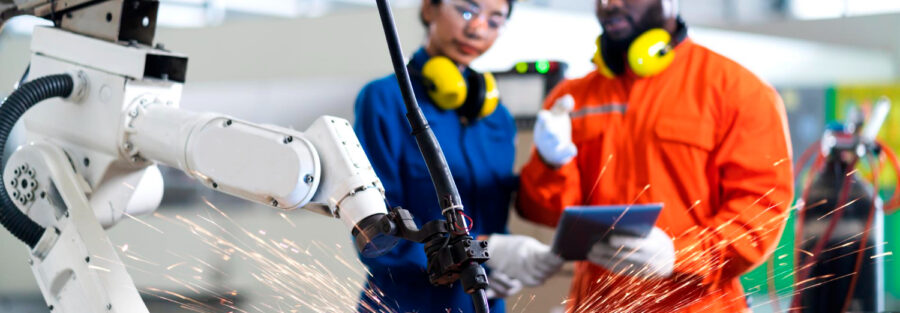Introduction
In the rapidly evolving landscape of manufacturing, Predictive Maintenance (PdM) has emerged as a game-changer. As industries strive to optimize operations, reduce downtime, and cut costs, machine learning is revolutionizing how manufacturers approach equipment maintenance. This article delves into the transformative role of machine learning in predictive maintenance, highlighting its benefits, applications, and future potential.
What is Predictive Maintenance?
Predictive maintenance is a proactive approach to maintaining equipment, focusing on predicting when a machine is likely to fail and performing maintenance just in time to prevent it. Unlike traditional maintenance strategies, which are either reactive (fixing equipment after it breaks) or preventive (regularly scheduled maintenance regardless of need), predictive maintenance aims to strike a balance by using data-driven insights to optimize maintenance schedules.
The Role of Machine Learning in Predictive Maintenance
Machine learning (ML) is at the core of predictive maintenance, enabling manufacturers to harness vast amounts of data from sensors, production lines, and historical maintenance records. By analyzing these data points, machine learning algorithms can identify patterns, detect anomalies, and predict potential failures with high accuracy.
1. Data Collection and Processing
The first step in predictive maintenance is collecting data from various sources. Sensors installed on machines continuously monitor parameters such as temperature, vibration, pressure, and other relevant factors. This raw data is then processed and cleaned, preparing it for analysis by machine learning models.
2. Model Training and Anomaly Detection
Machine learning models are trained using historical data, allowing them to learn the normal operating conditions of machinery. These models can then detect deviations from the norm, signaling potential issues before they lead to equipment failure. Advanced techniques like neural networks, decision trees, and clustering algorithms are commonly used in this stage.
3. Failure Prediction and Maintenance Scheduling
Once a machine learning model is trained, it can predict the likelihood of a machine failing within a specific timeframe. This prediction enables maintenance teams to schedule repairs at the most opportune times, minimizing disruption to production and extending the lifespan of equipment.
Benefits of Predictive Maintenance
The adoption of predictive maintenance in manufacturing offers several key benefits:
1. Reduced Downtime
By predicting and addressing issues before they cause equipment failure, predictive maintenance significantly reduces unplanned downtime. This ensures that production lines run smoothly and efficiently.
2. Cost Savings
Predictive maintenance helps avoid costly repairs and equipment replacements by addressing potential issues early. Additionally, it reduces the need for frequent, unnecessary preventive maintenance checks.
3. Improved Equipment Lifespan
Regularly monitoring and maintaining equipment based on its actual condition rather than a set schedule extends the lifespan of machinery. This leads to long-term savings and a better return on investment.
4. Enhanced Safety
By identifying potential equipment failures before they occur, predictive maintenance contributes to a safer working environment, reducing the risk of accidents caused by malfunctioning machinery.
Applications of Predictive Maintenance in Manufacturing
Predictive maintenance is being applied across various sectors of manufacturing, from automotive to electronics, and even in industries like oil and gas.
1. Automotive Industry
In the automotive sector, predictive maintenance is used to monitor assembly lines, robotic arms, and other critical machinery. By preventing breakdowns, manufacturers can maintain high production rates and ensure timely delivery of vehicles.
2. Electronics Manufacturing
In electronics manufacturing, where precision is key, predictive maintenance helps in maintaining the accuracy and efficiency of equipment used in assembling and testing electronic components.
3. Oil and Gas Industry
The oil and gas industry, known for its complex machinery and harsh operating conditions, benefits from predictive maintenance by reducing the risk of equipment failure and minimizing operational disruptions.
Challenges and Future of Predictive Maintenance
While predictive maintenance offers numerous benefits, it also comes with challenges. The accuracy of predictions relies heavily on the quality and quantity of data available. Additionally, the implementation of predictive maintenance requires significant investment in sensors, data storage, and advanced analytics platforms.
The Future of Predictive Maintenance
The future of predictive maintenance is promising, with advancements in artificial intelligence (AI) and the Internet of Things (IoT) set to enhance its capabilities. As machine learning algorithms become more sophisticated, they will provide even more accurate predictions, further optimizing maintenance schedules and reducing costs. Moreover, the integration of cloud computing and edge computing will enable real-time analysis and decision-making, making predictive maintenance more accessible and effective for manufacturers of all sizes.
Conclusion
Predictive Maintenance powered by machine learning is reshaping the manufacturing industry by providing a smarter, data-driven approach to equipment maintenance. As manufacturers continue to adopt these technologies, they can expect reduced downtime, lower costs, and improved operational efficiency. The future of manufacturing lies in the hands of predictive maintenance, where machine learning will continue to play a pivotal role in driving innovation and growth.



